Pathology 2.0 – Nine Years Later
More than 10 years ago, in 2007, the College of American Pathologists Foundation, then being led by Dr. Mary Kass, a former president of the College, started, or essentially brought back “CAP Futurescape”. The idea was to have an intense 2-day meeting close to a major airport where people could fly in and out for a weekend to discuss, as you can imagine, the future of pathology. A hotel close to O’Hare was decided. The first year there were projections from Wall Street to Main Street, from imaging to blood banking and everything in between. Retail clinics, self-service laboratory models and the threat/opportunity of whole slide imaging and telepathology. Nighthawk Radiology spoke about reading cases from Spain and Australia. Some in the room liked this idea. Some didn’t. Bruce Friedman over at labsoftnews.com, who I have mentioned numerous times before, challenged me to blog about emerging technologies at that 2007 meeting.
For whatever reason, I was on the program committee, responsible for suggesting topics, speakers, panels and the like. Regularly scheduled conference calls with Dr. Kass and Foundation staff started to mold the 2009 meeting. A few gaps remained heading into that June. We needed to fill a few more “slots”. As is the case with meeting planning, particularly if you do so too late, getting commitments from speakers can be tough, particularly for Summer months.
On one of those calls I suggested someone give a talk on “Pathology 2.0”. The group on the phone remained silent. I stared at my computer screen while holding the phone to my ear thinking, What the heck is that? A few seconds later Dr. Kass asked me a similar question screaming into my ear, What the f— is that?
I stuttered and stammered. I had no idea. The next generation of pathology? Like Web 2.0 versus Web 1.0? Pathology 1.0 versus Pathology 2.0? I said there must be something there to talk about and we could find someone to cover it. A visionary. Someone who had been at pathology more than a decade or two decades. Unfortunately, Dr. Kass selected me to do the talk since I came up with the idea and nobody else knew who the heck to ask.
This blog was a couple of years old. Twitter not as old. Facebook was becoming one of the largest “countries” on the planet although Facebook had fewer people subscribed then overall then look at it on a daily basis now. Sharing images and ideas and comments was becoming more popular. There had to be something there for pathology. And so, Pathology 2.0 made it to a PowerPoint slide a few months before June of 2009.
The title slide was easy. Now I had to make the case why this belonged in a talk at a meeting about the future of pathology.
I thought, what if you could tweet a diagnosis? What if you could post an image or series of images and get opinions from all over world, in real or near-real time? What if Facebook had groups of pathologists all talking about the same thing? GI or soft tissue, perhaps?
It would be a virtual worldwide multi-headed microscope, sharing, asking, collaborating, commenting and sharing with each other’s respective networks, be it Web 1.0 or Web 2.0, this was going to be Pathology 2.0. Surgical pathology was ideal given its image intense nature and easy access to upload and share that content, particularly with another change at this time – mobile computing and increasingly ubiquitous high-speed wireless networks. No pun intended, these went hand in hand. Photos from vacations would be on your phone as would images through your microscope objective. And gross images. And radiology. And immunohistochemical stains and molecular images. Flow cytometry and karyotypes. All digital, all in the palm of your hand and all available to share outside the walls of your institution with dizzying speed.
Today, it is hard to avoid Pathology 2.0. My Facebook and Twitter streams are full of cases, questions and teaching examples, from pathologists seeking opinions to well-known academics highlighting examples with teaching points.
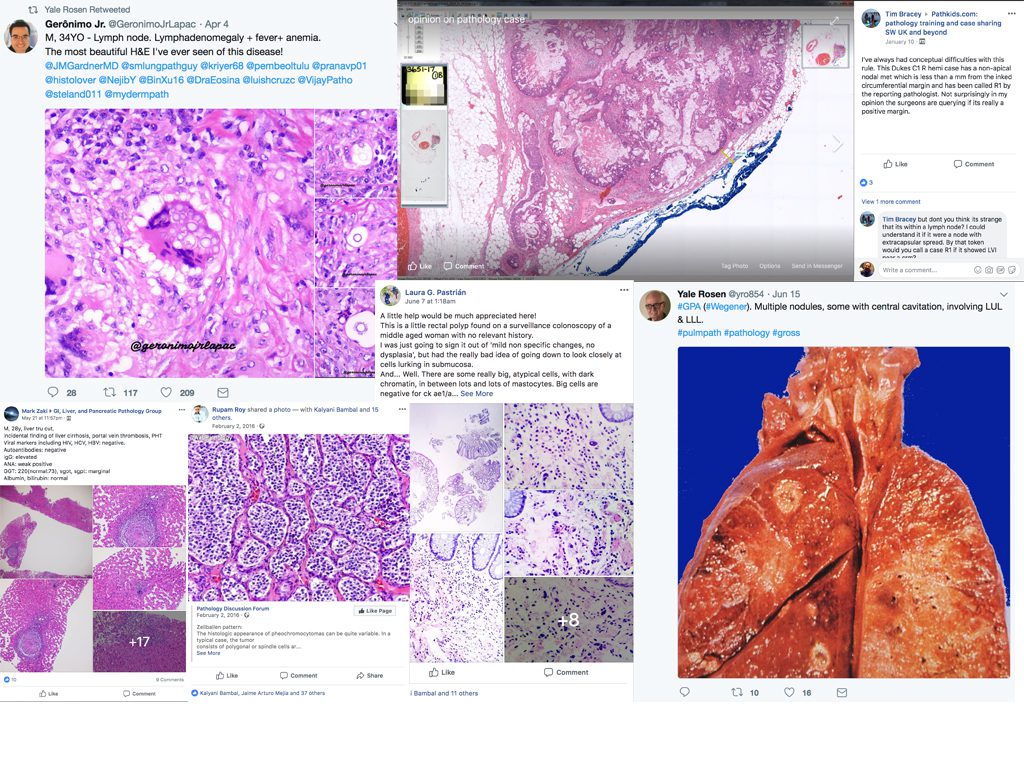
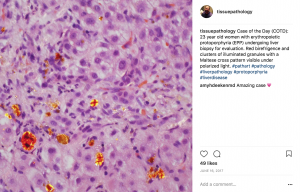 Of course, (more than once a year), I add my own examples and interesting cases and questions to my colleagues to the tens of thousands of cases online.
Of course, (more than once a year), I add my own examples and interesting cases and questions to my colleagues to the tens of thousands of cases online.
Among the dinner plates, beach photos and Friday night pizza nights seems to be an unending stream of disease. There is a bit of irony there but this is the world we as physicians live in. We likely comment and “like” as much on our daily lives with each other as we do on each other’s cases and academic and business achievements.
Outside of sharing cases and commentaries the other significant trend of Pathology 2.0 is the use of social media to share not only specific cases and institutional photos but also to share what one sees at meetings and conferences. The use of hashtags at medical meetings to post slides, exhibits, posters and social events allows one to see much more of the meeting than we once could or draw our attention to something worth seeing or doing while at the meeting. At a meeting many years ago, I shared a picture from dinner after “checking in” to the restaurant using the meeting hashtag. A few moments later I saw a similar tablecloth under the same entrée as I had from a former resident. Without knowing it, we were sitting 5 feet from each other with our backs to each other until we both looked up and turned around.
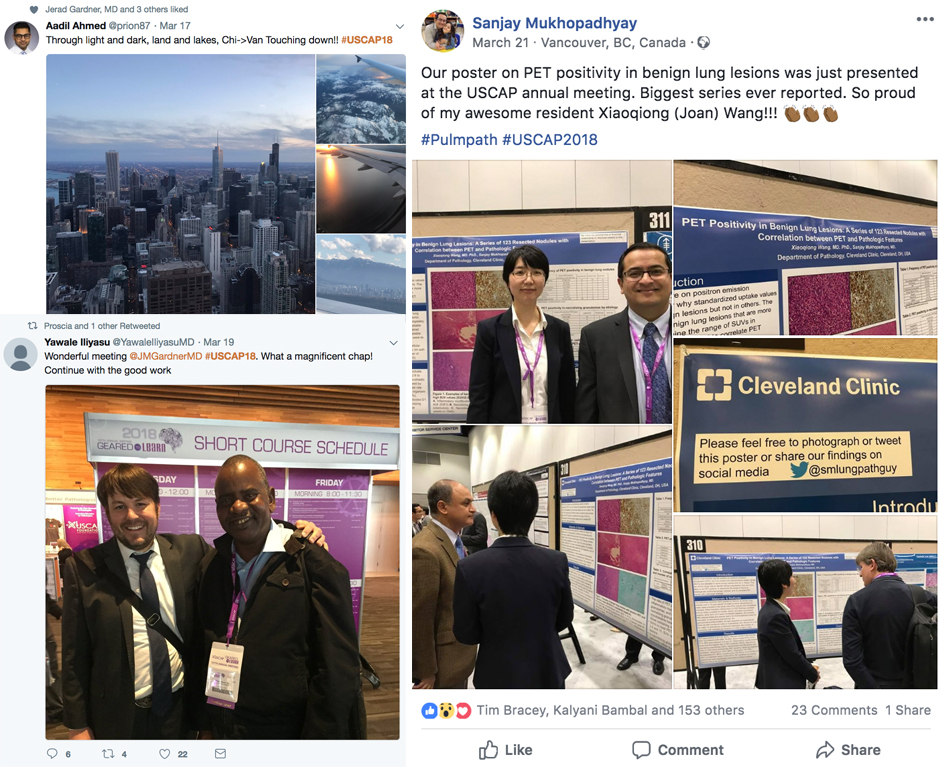
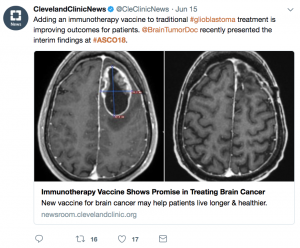 I would go so far as to say that if you can’t make the meeting, this is the next best thing. Updates on the latest trends in diagnosis and management. I couldn’t make it ASCO this year as I normally like but following #ASCO18 I felt as if I saw the talking points and areas of discussion that I need to follow and follow up on that were “trending” at the meeting. Of course, being there and tweeting or micro-blogging is preferred, but this is a close second and allows those who cannot attend to see follow the controversies along with simple airplane photos and scenic pictures from places you may never have visited or not visited in a while.
I would go so far as to say that if you can’t make the meeting, this is the next best thing. Updates on the latest trends in diagnosis and management. I couldn’t make it ASCO this year as I normally like but following #ASCO18 I felt as if I saw the talking points and areas of discussion that I need to follow and follow up on that were “trending” at the meeting. Of course, being there and tweeting or micro-blogging is preferred, but this is a close second and allows those who cannot attend to see follow the controversies along with simple airplane photos and scenic pictures from places you may never have visited or not visited in a while.
Of course, this is not for everyone. As with any form of “publication”, there is a significant difference between those who provide content and those who consume it. Some set themselves apart in terms of those who are uploading compared with those who are consuming. And there is a role for everyone. It is like going to a cattle auction or a rock concert, there is a motivated “seller” and motivated “buyer” and the goal is that both leave the venue satisfied that they got out of it what they put into it. Some folks perhaps are more private and don’t take pictures of desserts and sunrises and some do. And I think with a lot of personal tastes and ideas, this may change or evolve over time. Admittedly, I am more of a consumer of short Facebook posts and tweets than a producer outside of this platform. If the Chicago Cubs win the World Series again this Fall this will likely change again.

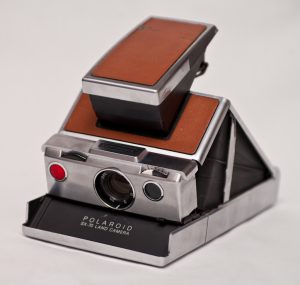 So, Pathology 2.0 is essentially doing what we have always done, just with different mediums. Polaroids have been replaced with Instagram. Letters and post cards have been replaced with posts and tweets. 35 mm slide shows from trips and lectures are now shared online albums.
So, Pathology 2.0 is essentially doing what we have always done, just with different mediums. Polaroids have been replaced with Instagram. Letters and post cards have been replaced with posts and tweets. 35 mm slide shows from trips and lectures are now shared online albums.
The millennials reading this are still trying to figure out what polaroids and 35 mm slides are…
What will Pathology 3.0 look like?
The Futurescape of Pathology Conference Series (I in 2007 and IV in 2011 with no conference in 2010) was not held beyond 2011. Many of the presentations are still online. There were presentations on moving beyond morphology, teleconsultation, image analytics, personalized medicine, genomics, biomarkers, imaging workstations, barcoding and national laboratory networks. See for yourself if the predictions were accurate.
Neils Bohr, Dwight Eisenhower, Mark Twain, and even the great philosopher, Yogi Berra are all credited with recognizing it is hard to make predictions, particularly about the future.
If I ever knew, I don’t recall the issues why the conference was not held beyond 2011. I think 2010 saw the hotel venue have some issues meeting their obligations in the wake of the financial issues of 2008 (which few predicted…).
Perhaps we should bring the meeting back. We can talk about moving beyond morphology, teleconsultation, image analytics, personalized medicine, genomics, biomarkers, imaging workstations, barcoding and national laboratory networks and Pathology 3.0!
Additional Reading:
CAP Today 2009 – Pathology 2.0
Dark Daily 2009 – Pathology 2.0
LinkedIn 2016 – Pathology 2.0 (additional references)
Archives 2008 – Dr. Jared Schwartz
Comments (2)
Eric Glassy, MD Jared N Schwartz Keith thanks for remembering Futurescape and Dr Kass’s amazing force and willpower to get it off the ground. The specific purpose was to have a forum where CAP could bring together pathologists
from all practice settings to learn about new medical technologies
that would soon or were already ready for clinical
use. New diagnostics, impact of digitization, new optical imaging and image analysis methods (in vitro and in vivo), increasing new powerful methods in proteomics, genomics (NGS), etc.
The speakers were carefully selected (not sure how you slipped in🤔) from many areas of medicine and industry. The one common
criteria were all these new technologies would in our opinion have major impacts on Pathology (including pathologists providing more
direction on drug development and use), improving diagnostic sensitivity and specificity and would ultimately impact every aspect of Pathology. The PRIMARY purpose of conference was to “ cry out” that if Pathology Leadership (ABP/APC/ Professional Society’s and others did not act NOW “2007” these Pathology tools of “future”would be lost to Pathology and adopted by others. It is now 2018. Many leaders (sadly not near enough) did heed the call and now many of above are considered part of Pathology, however not enough has changed particularly as regarding the intense training required to ensure our residents and fellows are prepared to go into practice and integrate these technologies into the everyday practice of pathology. Other Specialties already have or are moving much faster to incorporate many of above technologies into their Board Certification requirements and thus their training programs are working hard to adequately prepare their residents for use of these tools themselves as they move into active practice.
I optimistically “believe”not too late for Pathology but without aggressive action by ABP/APC and others our Specialty in danger of being viewed as technicians rather than physicians by House of
Medicine and Healthcare Policy Makers. Our trainees need mentors
to guide and encourage them. Where are they? Again Thanks
Keith for remembering FutureScape and also reminding us that much remains to be done.




















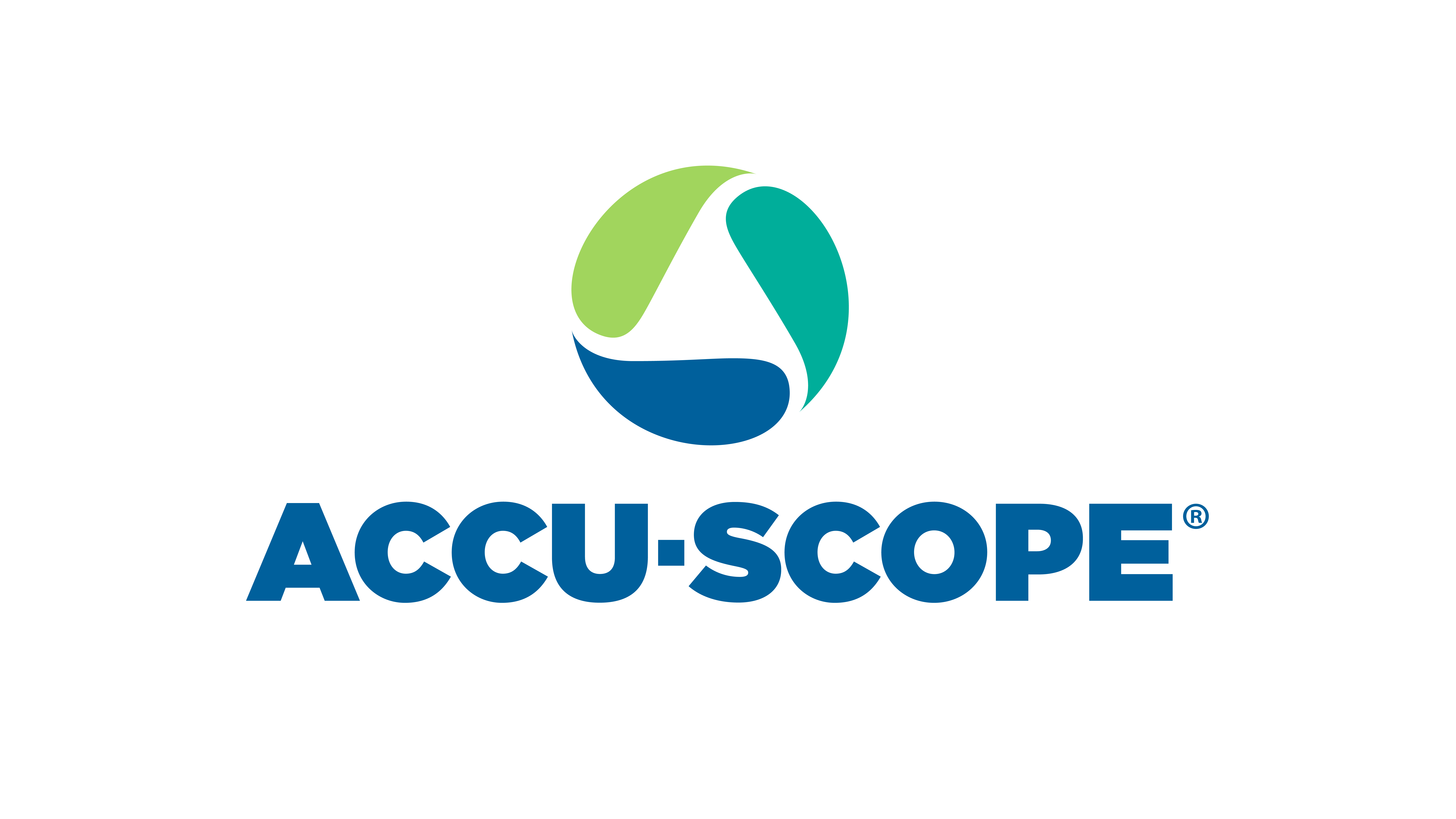
















Keith
Yes!
Let’s bring back Futurescape.
Pathology 3.0 with Machine Learning, Artificial Intelligence, Big Data and Computational Pathology.
Thanks for reminding us of how good FutureScape was.
Eric